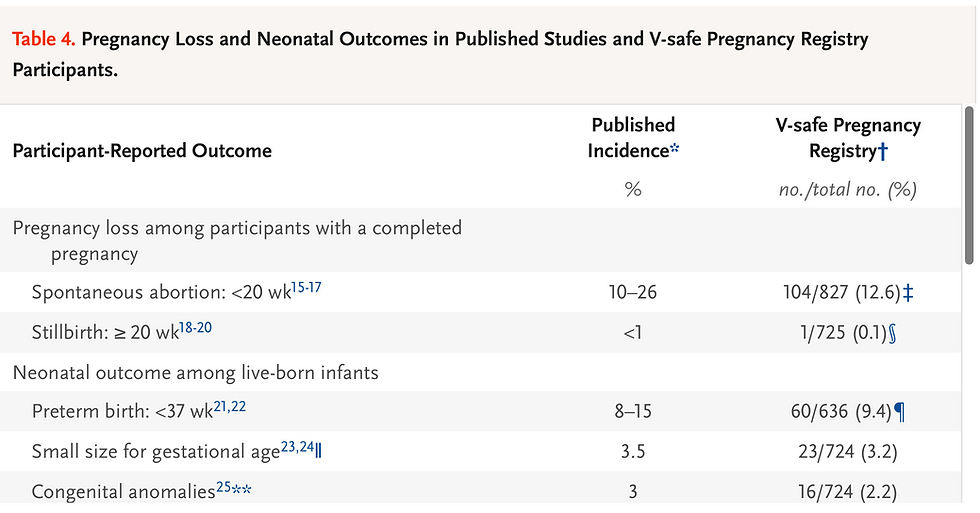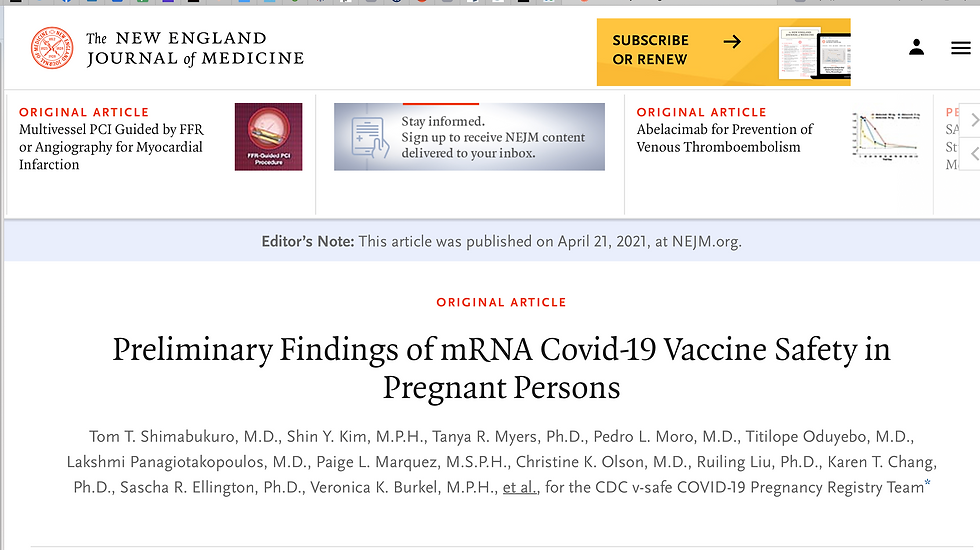NEJM paper demonstrates mRNA vaccines do NOT increase miscarriage rate.
- Jeffrey Morris

- Jul 21, 2021
- 4 min read
Updated: Jul 23, 2021
There are numerous claims circulating on social media suggesting that the mRNA vaccines are dangerous to reproductive health and fertility of women, and in particular causing miscarriages. The Vaccine Adverse Event Reporting System (VAERs) have numerous reports of "spontaneous abortion" (i.e. miscarriage) listed for women after vaccination, and many people read that to indicate the vaccines caused the miscarriages even though the VAERs site clearly explains that many reported events might be coincidental and not caused by the vaccines. For this reason, VAERs alone cannot be used to establish whether a vaccine is causing a particular adverse event such as miscarriage. Miscarriages are very common in pregnancies, occurring in 10-15% of all known pregnancies, and 80% of which occur in the first trimester. So it is important to go beyond VAERs to assess the potential harm of vaccines using one of the other active monitoring systems that the CDC and FDA run.
One such system is Vsafe, an after vaccination text-based health checker to survey recipients and track side effects after vaccination. As of July 19, 2021, there were >136,000 participants in Vsafe who reported they were pregnant, of which 5,101 have signed up for the V-safe COVID-19 Vaccine Pregnancy Registry, which specifically tracks health of pregnant women and their fetuses after vaccination during pregnancy.
A preliminary analysis of these data was done in April 2021 and results presented in a New England Journal of Medicine peer-reviewed paper. At this time, they had 3,958 participants in the V-safe COVID-19 Vaccine Pregnancy Registry, of which 827 had a completed pregnancy and 3,131 were still pregnant at the time of the analysis. These individuals were vaccinated between December 14, 2020 and February 28, 2021, and the analysis was done March 30, 2021, so there was between 4 and 15 weeks follow up after vaccination.
Following is a key table dealing with miscarriages in vaccinated women:

Out of 827 completed pregnancies, 104 ended in miscarriage, which is 12.6% of completed pregnancies. Of these miscarriages, 96 were vaccinated in the first trimester. There are some widely circulated claims on social media based on an unpublished letter to the editor to NEJM claim that the data in this study suggest a MUCH higher miscarriage rate. Their reasoning is that 700 of the 827 completed pregnancies were third trimesters, a time at which miscarriages rarely happen. Thus, they claim, the real rate of spontaneous abortion "should be" 104/(827-700) = 104/127 >82%. Of course, this letter to the editor was rejected by NEJM for invalid methodology, but this was taken as a badge of honor by those forwarding it around on social media, implying NEJM must be colluding to suppress evidence of vaccine danger. Of course, their claim is preposterous, and assuming this 104/127 represents the proportion of vaccinated 1st and 2nd trimester women who miscarried completely ignores the 3,131 who were still pregnant at the time of the analysis! Whoops! This is a huge mistake, since women vaccinated in the first trimester could not have delivered a healthy baby at the time of the analysis and paper writing. Actually, the 12.6% included in the paper above is not terribly informative either, as it only looks at those with competed pregnancies and also ignores the many who were still pregnant at the time of analysis. One way to assess miscarriage rate after vaccination would be to look at proportion of 1st trimester vaccinations that resulted in miscarriage. We know 96 1st trimester vaccinations resulted in miscarriage out of a total of 1132 vaccinated in the first trimester. Thus, we see at the time of writing, a total of 96/1132=8.5% of pregnant women vaccinated during the first trimester had miscarriages, well within the 8-12% estimated background rate of first trimester miscarriages.
As a result, this study showed no evidence that vaccination increased the risk of miscarriage, as the miscarriage rate in the first trimester, when 80% of miscarriages occur, was no higher in vaccinated people in the V-safe COVID-19 Vaccine Pregnancy Registry than the background population rate of 8-12%.
The V-safe registry is more able to provide legitimate miscarriage rate estimates since we know the denominator of the rate (# signed up for the registry) and reliably know the from the fact that all registry participants were contacted that the numerator of the rate (# with miscarriages) is also accurate.
This also shows that indeed the FDA and CDC are concerned about vaccine safety, instituting the VAERs system as well as numerous active vaccine safety surveillance systems and studies including V-save, VSD, CISA and other systems. People who are alarmed about vaccine safety based on solely looking at VAERs counts and inferring all are caused by vaccine should look to the analyses in these systems to assess whether indeed the reported events after vaccination are above background rates, and thus likely to be caused by the vaccine.
Now there is a chance that there could have been some more miscarriages in the later vaccinated women who were still in the first trimester at the time of the analysis, but not enough to provide evidence that the miscarriages were occurring above the background rate. Given the full data the best analysis would be a “time to miscarriage” analysis that accounted for the censored data (pregnancy ongoing no miscarriage yet) and lead time bias (miscarriage could not have occurred before vaccination or they wouldn’t be in this cohort). This would provide a more rigorous and robust assessment.
There is another paper in Journal of the American Medical Association published on July 12, 2021 that tracked 7530 vaccinated and 7530 matched unvaccinated women. They found 128 vaccinated women had miscarriages (1.7%), and 118 unvaccinated women had miscarriages (1.6%), again agreeing with the notion that vaccination does not raise risk of miscarriage.








Valuable content and presentation <->} Crown Town Pune {} Ravet Crown {} Nigdi Crown {} Wakad Crown {} Marunji Crown {} Hinjewadi Crown {} Pcmc Crown {} Baner Crown {} Aundh Crown {} Pimple Saudagar Crown {] Shivaji Nagar Crown {] Kalyani Nagar Crown {} Viman Nagar Crown {} Koregaon Park Crown {} Kharadi Crown {} Magarpatta city Crown {] Deccan Crown }{ {] Bavdhan Crown
The Real Pune Service I chose possessed a remarkable combination of charm, intellect, and beauty. From start to finish, the service was flawless, and I felt completely at ease the entire time.
Good to see some solid data debunking the misinformation out there! It's important to have access to accurate info about vaccines, especially for pregnant women. Makes me wonder what else is being misconstrued online. Anyway, gotta get back to training my skills on Roblox with my blue lock rivals !
best iptv : Welcome to Best IPTV 4K, your number one destination for premium-quality IPTV streaming. We bring you the future of television — thousands of live channels, movies, and series available in crystal-clear 4K Ultra HD. With lightning-fast servers, a smooth user interface, and zero-buffering performance, Best IPTV 4K ensures that your viewing experience is seamless and enjoyable every time.
Whether you’re a fan of live sports, movies, international channels, or entertainment shows, we’ve got you covered with a vast and diverse selection of content from all around the world. Our service is compatible with all major devices — including Smart TVs, Android boxes, Firestick, and mobile devices — making it easy to enjoy your favorite programs anytime, anywhere.
At…